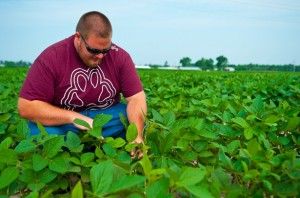College engineers disease-resistant soybeans

July 9, 2013
The university has developed a new type of soybean that will have a natural resistance to one of the most devastating diseases affecting soybean production in the Midwest.
The new variety of soybean, codenamed Saluki 4313, has a built-in resistance to soybean cyst nematode. Soybean cyst nematode is a plant parasitic nematode, which attacks the roots of soybeans and can result in the suppression of shoot growth, root necrosis and a significant loss in seed yield. Stella Kantartzi, assistant professor of plant, soil and agricultural systems, said the new variety of soybean should be able to fight off SCN and assist farmers in the production of soybeans in the Midwest.
Advertisement
Kantartzi said she has been working with the university to engineer a foundation seed, which will help develop soybean seeds with resistance to SCN in the next two years.
“SCN causes nearly $1 billion in soybean crop losses almost every year,” she said. “With a disease like SCN, which affects such a large portion of one of America’s leading cash crops, finding a cure could potentially save many of the crops for years to come.”
Bryan Young, professor of plant, soil and agricultural systems, said soybeans are one of Illinois’ most prominent cash crops right behind corn.
“They are the second largest crop produced in our state in terms of bushels produced, as well as acres of production,” he said. “ This year alone, Illinois has produced somewhere between eight or nine million acres of soybeans, so it is important to Midwestern agriculture.”
Brian Klubek, department chair of the plant, soil and agricultural systems department, said the proteins in soybeans are used in the production of many different food items, such as livestock feed for hogs and chickens.
“It is a good vegetative protein source for raising animals and the oil can be used for various things, like proteins found in tofu and protein bars,” he said. “It is also the number one edible oil people find in grocery stores. When something says it has vegetable oil in it, it is most likely soybean oil.”
Young said soybeans do not see much use in southern Illinois because of the lack of hog and chicken livestock when compared to the rest of America, but Illinois’ geography makes it easier to grow and harvest soybeans during the fall.
Advertisement*
Klubek said other than SCN, some of the difficulties that come with growing soybeans are weed infestations and sudden death syndrome. He said it is important that farmers are wary of weed infestations, rainfall and diseases if they want to help increase their production of soybeans.
He said soybean production depends on a few key factors, such as where the crop is located, weather, climate and moisture availability.
Young said many diseases, such as SCN, often affect the growth production of soybeans so researchers always look for new ways to address these issues.
He said different types of soybeans that are bred to resist disease, such as Saluki 4313, are brought up by the university to resist many of the aliments that plague soybeans.
The university has done more work on SCN, SDS, plant pathology and breeding than some other institutions to try and develop a possible cure for the problems that plague soybean production.
Kantartzi said her developments with Saluki 4313 would hopefully give American farmers the edge they need to fight off SCN in the near future.
“Soybeans are an important part of the diets and food production in the Midwest,” she said. “By developing new ways to resist SCN, we are also saving the hard work of local farmers in Illinois and other states that depend on the production of soybeans.”
Advertisement







